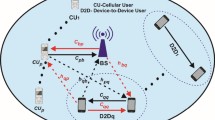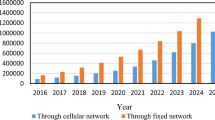Abstract
To increase spectrum efficiency, the radio resource management with frequency reuse factor = 1 is usually adopted in multi-cell orthogonal frequency division multiple access systems. Such a reuse-one strategy results in severe co-channel interference, especially penalizing mobile users near the cell border. This paper presents an effective subcarrier-assignment algorithm to mitigate the co-channel interference for multi-cell orthogonal frequency division multiple access downlink systems. The proposed algorithm consists of an initial assignment phase and a compensation phase. In the first phase, each subcarrier is assigned to mobile users with higher channel gains and lower mutual co-channel interferences. The second phase further compensates mobile users who do not get adequate resources to meet the requirement of quality of service in the first phase. System simulation results reveal that the proposed algorithm can significantly improve the number of QoS-satisfied users compared with previous used scheme.










Similar content being viewed by others
References
Song, G., & Li, Y. (2005). Cross-layer optimization for OFDM wireless networks—part I: theoretical framework. IEEE Transactions on Wireless Communications, 4(2), 614–624.
Kim, I., Park, I. S., & Lee, Y. H. (2006). Use of linear programming for dynamic subcarrier and bit allocation in multiuser OFDM. IEEE Transactions on Vehicular Technology, 55(4), 1195–1207.
Ali, S. H., & Leung, V. C. M. (2009). Dynamic frequency allocation in fractional frequency reused OFDMA networks. IEEE Transactions on Wireless Communications, 8(8), 4286–4295.
Wong, C. Y., Cheng, R. S., Letaief, K. B., & Murch, R. D. (1999). Multiuser OFDM with adaptive subcarrier, bit and power allocation. IEEE Journal on Selected Areas in Communications, 17(10), 1747–1758.
Ermolova, N. Y., & Makarevitch, B. (2007). Low complexity adaptive power and subcarrier allocation for OFDMA. IEEE Transactions on Wireless Communications, 6(2), 433–437.
Ganti, A., Klein, T. E., & Haner, M. (2006). Base station assignment and power control algorithms for data users in a wireless multiaccess framework. IEEE Transactions on Wireless Communications, 5(9), 2493–2503.
Sadr, S., Anpalagan, A., & Raahemifar, K. (2009). Radio resource allocation algorithms for the downlink of multiuser OFDM communication systems. IEEE Communications Surveys & Tutorials, 11(3), 92–106.
Li, G., & Liu, H. (2006). Downlink radio resource allocation for multi-cell OFDMA system. IEEE Transactions on Wireless Communications, 5(12), 3451–3459.
Venturino, L., Prasad, N., & Wang, X. (2009). Coordinated scheduling and power allocation in downlink multicell OFDMA networks. IEEE Transactions on Vehicular Technology, 58(6), 2835–2848.
Gault, S., Hachem, W., & Ciblat, P. (2007). Performance analysis of an OFDMA transmission system in a multicell environment. IEEE Transactions on Communications, 55(4), 740–751.
Lei, H., Zhang, L., Zhang, X., & Yang, D. (2007). A novel multi-cell OFDMA system structure using fractional frequency reuse. In Proceeding of IEEE PIMRC (pp. 1–5).
Ghaffar, R., & Knopp, R. (2010). Fractional frequency reuse and interference suppression for OFDMA networks. In Proceeding of international Symposium on modeling and optimization in mobile, Ad Hoc, and wireless networks (pp. 273–277).
Doppler, K., Wijting, C., & Valkealahti, K. (2009). Interference aware scheduling for soft frequency reuse. In Proceeding of IEEE 69th vehicular technology conference (pp. 1–5).
Bohge, M., Gross, J., & Wolisz, A. (2009). Optimal power masking in soft frequency reuse based OFDMA networks. In Proceeding of European wireless conference (pp. 162–166).
Kosta, C., Hunt, B., Quddus, A. U., & Tafazolli, R. (2013). On interference avoidance through inter-cell interference coordination (ICIC) based on OFDMA mobile systems. IEEE Communications Surveys & Tutorials, 15(3), 973–995.
Hamza, A. S., Khalifa, S. S., Hamza, H. S., & Elsayed, K. (2013). A survey on inter-cell interference coordination techniques in ofdma-based cellular networks. IEEE Communications Surveys & Tutorials, 15(4), 1642–1670.
Lv, G., Zhu, S., & Hui, H. (2009). A distributed power allocation algorithm with inter-cell interference coordination for multi-cell OFDMA systems. In Proceeding of IEEE GLOBECOM (pp. 1–6).
López-Pérez, D., Güvenç, Í., de la Roche, G., Kountouris, M., Quek, T. Q. S., & Zhang, J. (2011). Enhanced intercell interference coordination challenges in heterogeneous networks. IEEE Wireless Communications, 18(3), 22–30.
Boudreau, G., Panicker, J., Guo, N., Chang, R., Wang, N., & Vrzic, S. (2009). Interference coordination and cancellation for 4G networks. IEEE Communications Magazine, 47(4), 74–81.
Jorswieck, E., & Mochaourab, R. (2009). Power control game in protected and shared bands: Manipulability of Nash equilibrium. In Proceeding of international conference on game theory for networks (pp. 428–437).
La, Q. D., Chew, Y. H., & Soong, B.-H. (2009). An interference minimization game theoretic subcarrier allocation algorithm for OFDMA-based distributed systems. In Proceeding of IEEE GLOBECOM (pp. 2799–2804).
Yu, Q., Chen, J., Fan, Y., Shen, X., & Sun, Y. (2010). Multi-channel assignment in wireless sensor networks: A game theoretic approach. In Proceeding of IEEE INFOCOM (pp. 1127–1135).
Necker, M. C. (2008). Interference coordination in cellular OFDMA networks. IEEE Network, 22(6), 12–19.
Chang, R. Y., Tao, Z., Zhang, J., & Kuo, C. -C. J. (2009). A graph approach to dynamic fractional frequency reuse (FFR) in multi-cell OFDMA networks. In Proceeding of IEEE international conference on communications (pp. 1–6).
Chang, R. Y., Tao, Z., Zhang, J., & Kuo, C.-C. J. (2009). Multicell OFDMA downlink resource allocation using a graphic framework. IEEE Transactions on Vehicular Technology, 58(7), 3494–3507.
Zhang, H., Liu, H., Cheng, J., & Leung, V. C. M. (2018). Downlink energy efficiency of power allocation and wireless backhaul bandwidth allocation in heterogeneous small cell networks. IEEE Transactions on Communications, 66(4), 1705–1716.
Zhang, H., Liu, N., Long, K., Cheng, J., Leung, V. C. M., & Hanzo, L. (2018). Energy efficient subchannel and power allocation for the software defined heterogeneous VLC and RF networks. Early Access: IEEE Transactions on Selected Areas in Communication.
Mokari, N., Alavi, F., Parsaeefard, S., & Le-Ngoc, T. (2016). Limited-feedback resource allocation in heterogeneous cellular networks. IEEE Transactions on Vehicular Technology, 65(4), 2509–2521.
Zhang, H., Yang, N., Long, K., Pan, M., Karagiannidis, G. K., & Leung, V. C. M. (2018). Secure communications in NOMA system: Subcarrier assignment and power allocation. IEEE Transactions on Selected Areas in Communication, Accepted.
Yassin, M., Lahoud, S., Ibrahim, M., Khawam, K., Mezher, D., & Cousin, B. (2017). Cooperative resource management and power allocation for multiuser OFDMA networks. IET Communications, 11(16), 2552–2559.
Ferdouse, L., Ejaz, W., Raahemifar, K., Anpalagan, A., & Markandaier, M. (2017). Interference and throughput aware resource allocation for multi-class D2D in 5G networks. IET Communications, 11(8), 1241–1250.
Nam, C., Joo, C., & Bahk, S. (2015). Joint subcarrier assignment and power allocation in full-duplex OFDMA networks. IEEE Transactions on Wireless Communication, 14(6), 3108–3119.
Kang, Y., Kim, K., & Park, H. (2007). Efficient DFT-based channel estimation for OFDM systems on multipath channels. IET Communications, 1(2), 197–202.
Coelho, F., Dinis, R., & Montezuma, P. (2011). Efficient channel estimation for single frequency broadcast systems. In Proceeding of VTC (pp. 1–6).
Raval, J. K., Patel, V. K., & Shah, D. J. (2013). Research on pilot based channel estimation for LTE downlink using LS and MMSE technique. International Journal of Electronics and Communication Engineering and Technology, 4(3), 70–82.
Liu, Y.-S., You, S. D., & Liu, Y.-M. (2015). Iterative channel estimation method for long-term evolution downlink transmission. IET Communications, 9(15), 1906–1914.
Welsh, D. J. A., & Powell, M. B. (1967). An upper bound for the chromatic number of a graph and its application to timetabling problems. The Computer Journal, 10(1), 85–86.
Author information
Authors and Affiliations
Corresponding author
Rights and permissions
About this article
Cite this article
Chih, TH., Su, SL. & Hung, TM. Two-phase downlink subcarrier allocation for multicell OFDMA systems. Wireless Netw 25, 2081–2090 (2019). https://doi.org/10.1007/s11276-018-1798-9
Published:
Issue Date:
DOI: https://doi.org/10.1007/s11276-018-1798-9




